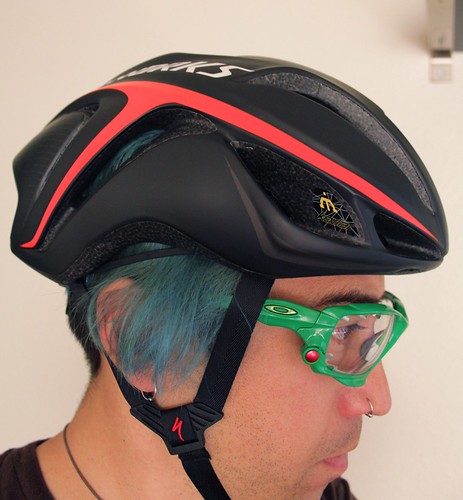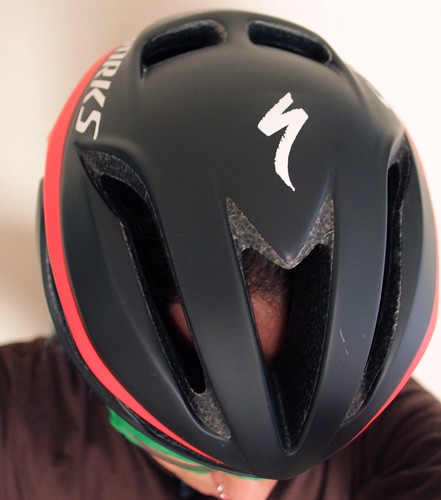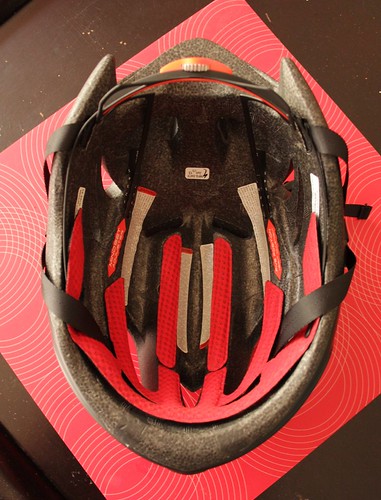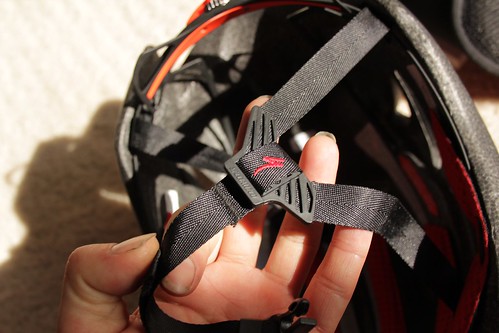
While “enduro” is the hot trend in mountain bikes and accessories, “aero-road” is the new black for the pavement posse. In the pursuit of performance, aerodynamics is the last area ripe for exploitation. Specialized has been a leader in using aerodynamics as a major design philosophy for all aspects of road riding, and one of their sponsored teams rosters the best road sprinter of the day. You don’t need to be Nostradamus to foretell that Specialized was going to market an aero-road helmet and that it was going to be a strong product. They did, it is, and the helmet is called the Evade. Specialized claims that the helmet will save 46secs over 40km, or perhaps even more enticing to the sprinter set, 2.6m over a 200m sprint.
There is a good rule of thumb when talking about contributions to aerodynamic drag. In terms of equipment, wheels are most important, then the fork, then the frame. But you as a rider contribute more drag than all those other factors combined….and frankly your head is just awful, aerodynamically speaking. The only way to make it worse is to wear a giant wiffle ball atop your kopp. But a full time trial helmet (besides being illegal for mass start races) is just too bulky and has a narrow range of positioning and conditions in which it can provide a practical improvement. Enter the aero-road helmet. The general concept is simple: take the full TT helmet, shorten it to regulations, round the shape so the helmet aerodynamically works for varying head positions, and make it just ventilated enough that it can be comfortable in a long road race. Besides Specialized, other manufacturers to debut aero-road helmets include Bell, Giro, and Kask; all follow this basic formula.

That Specialized makes big claims of performance gains isn’t exactly a surprise; Specialized has always had a smart marketing thrust. I expect that 2014 will see an aero-road helmet from all the other big name helmet makers. This is going to be a high-profile trend, but is it just hype? Well, the science is there to support the concept, but whether or not you as a rider could ride fast enough to acquire any drag savings is debatable. On the other hand, the only real disadvantage to an aero-road helmet is that it probably is heavier and not as well vented compared to comparable conventional road helmets. If those two obstacles could be overcome, then an aero-road helmet could be beneficial whenever you go fast and is never a bother when it can’t be used to advantage. In the Evade helmet, Specialized more or less accomplishes that.
At 261gr in a medium size, the Evade is lighter than many high-end conventional road models. With many helmets I am uncomfortably between medium and large sizes if there are 3 sizes to choose. I find that the medium Evade fits my head exactly with the thin pads, but that might be because the back portion of the shell is rather open, so my oblong head has a little more room. There really is no room to fit a helmet liner or hat either. I was frankly surprised how comfortable this helmet is. The rear strap system, which Specialized calls Mindset, goes a long way to provide a secure fit despite its structural minimalism. The web straps are remarkably thin and light. The TriFix web splitter might reduce the web straps’ adjustability, but it is hard to fault the comfort and reduced complexity. When riding with the Evade, the helmet definitely seems to have a smoother airflow , with little buffeting sensation that I get from typical road helmets. The rear vents seem to vacuum hot air off your scalp as long as you are traveling more than 15mph.
The Evade has a small profile, adding barely any bulk to the rider’s head. Abdicating the long tails of full TT helmets, this helmet has a shorter, rounder shape that works better in a range of wind angles and head positions. The intake vents are kept to slim slots with particular attention paid to the internal channels and the rear exhaust ports. By keeping the helmet low profile and minimizing air flow into the helmet, the Evade hits all its performance targets, but by optimizing air channels to make the best use of the flow taken in, the same helmet seemed adequately cool enough to use except in very warm and slow conditions (ie, not a good choice for a summer hill climb). I found that the Evade was comfortable enough for most riding conditions, if not for the high summer. Aero-road helmets have been used at winter cyclocross races, early spring road classics, and even the Leadville 100, which is a sign that athletes believe that these helmets are not limited to specific conditions, that when heat is not a race factor then these helmets are without disadvantages….that an aero-road helmet is a worthy choice even if there’s only a slim chance that it could provide a decisive advantage.
I have ridden the helmet for a few weeks, and I’m impressed at how comfortable and practical it has proven. But can I verify the performance claims? No, and I wouldn’t believe anyone who claimed they did unless they provided numbers and robust test protocol from a wind tunnel study not owned or funded by Specialized. But the general science is sound. At $250, the Evade is no bargain lid, but it is no more expensive than comparable offerings from competing brands. But consider that the time savings that the Evade purports to offer are on par with performance claims of $3000-6000 aero-road framesets, and that price seems pretty reasonable.




We're riding townies, adventure, and mountain bikes. Find recommendations on our store page. As Amazon Associates we earn from qualifying purchases.